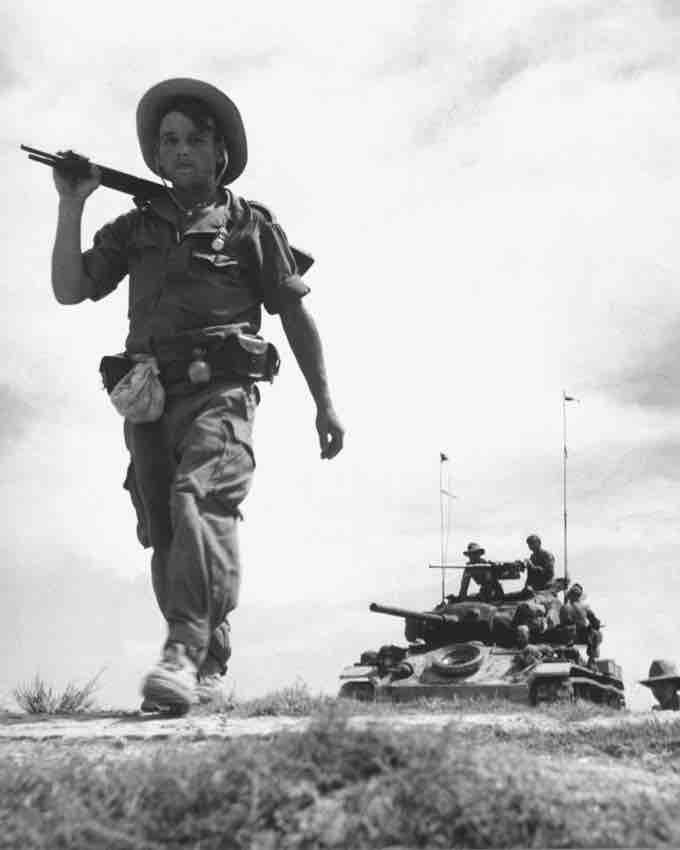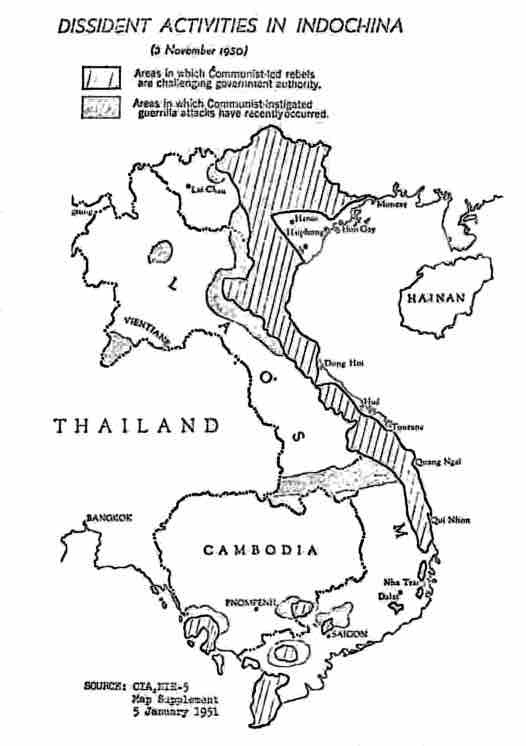BACKGROUND
France began its conquest of Indochina in the late 1850s, and completed pacification by 1893. The 1884 Treaty of Hue formed the basis for French colonial rule in Vietnam for the next seven decades. In spite of military resistance, by 1888 the area of the current-day nations of Cambodia and Vietnam was made into the colony of French Indochina (Laos was later added to the colony). Various Vietnamese opposition movements to French rule existed during this period but none was ultimately as successful as the Viet Minh common front, which was founded in 1941 under the leadership of Ho Chi Minh, controlled by the Indochinese Communist Party, and funded by the U.S. and the Chinese Nationalist Party in its fight against Imperial Japanese occupation.
During World War II, the French colonial authorities, in French Indochina, sided with the Vichy regime. In September 1940, Japan invaded Indochina. Following the cessation of fighting and the beginning of the Imperial Japanese occupation, the French colonial authorities collaborated with the Japanese. The French continued to run affairs in Indochina, but ultimate power resided in the hands of the Imperial Japanese. The Viet Minh was founded as a league for independence from France, but also opposed Japanese occupation in 1945 for the same reason.
The Viet Minh took power in Vietnam in the August Revolution (launched by the Viet Minh against French colonial rule on August 14, 1945). However, the major allied victors of World War II, the United Kingdom, the United States, and the Soviet Union, all agreed the area belonged to the French. As the French did not have the means to immediately retake Vietnam, the major powers came to an agreement that British troops would occupy the south while Nationalist Chinese forces would move in from the north. Nationalist Chinese troops entered the country to disarm Imperial Japanese troops north of the 16th parallel on September 14, 1945. When the British landed in the south, they rearmed the interned French forces as well as parts of the surrendered Imperial Japanese forces to aid them in retaking southern Vietnam, as they did not have enough troops to do this themselves.
In January 1946, the Viet Minh won elections across central and northern Vietnam. The French landed in Hanoi by March 1946 and in November of that year they ousted the Viet Minh from the city. British forces departed on March 26, 1946, leaving Vietnam in the hands of the French. Soon thereafter, the Viet Minh began a guerrilla war against the French Union forces, beginning the First Indochina War.
THE FIRST INDOCHINA WAR
The First Indochina War began in French Indochina on December 19, 1946 and lasted until August 1, 1954. Most of the fighting took place in Tonkin in Northern Vietnam, although the conflict engulfed the entire country and also extended into the neighboring French Indochina protectorates of Laos and Cambodia. The first few years of the war involved a low-level rural insurgency against French authority. However, after the Chinese communists reached the Northern border of Vietnam in 1949, the conflict turned into a conventional war between two armies equipped with modern weapons supplied by the United States and the Soviet Union.

A French Foreign Legion Unit Patrols in a Communist-Controlled Area.
The original caption of this photo reads: "A French Foreign Legionnaire goes to war along the dry rib of a rice paddy, during a recent sweep through communist-held areas in the Red River Delta, between Haiphong and Hanoi. Behind the Legionnaire is a U.S. gifted tank. Ca. 1954."
The war culminated in a decisive French defeat at the Battle of Dien Bien Phu. At the International Geneva Conference on July 21, 1954, the new socialist French government and the Viet Minh made an agreement that was denounced by the government of Vietnam and by the United States, but which effectively gave the Communists control of North Vietnam above the 17th parallel. Control of the north was given to the Viet Minh under Ho Chi Minh, and the south continued under Emperor Bao Dai (former Emperor of Vietnam and at the time the chief of state of the State of Vietnam or South Vietnam). The Geneva Accords promised elections in 1956 to determine a national government for a united Vietnam. However, the United States and the State of Vietnam refused to sign the document. From his home in France, Emperor Bao Dai appointed Ngo Dnh Diem as Prime Minister of South Vietnam. In 1955, with American support, Diem used a referendum to remove the former Emperor and declare himself the president of the Republic of Vietnam. When the elections were cancelled, the Viet Minh cadres who stayed behind in South Vietnam were activated and started to fight the government. North Vietnam also invaded and occupied portions of Laos to assist in supplying the guerrilla fighting National Liberation Front in South Vietnam. The war gradually escalated into the Second Indochina War, more commonly known as the Vietnam War in the West and the American War in Vietnam.
THE BEGINNING OF THE SECOND INDOCHINA WAR
At the beginning of the war, the U.S. was neutral in the conflict because of opposition to European imperialism, because the Viet Minh had recently been their allies, and because most of its attention was focused on Europe where Winston Churchill argued an Iron Curtain had fallen. Then the U.S. government gradually began supporting the French in their war effort, primarily through Mutual Defense Assistance Act, as a means of stabilizing the French Fourth Republic in which the French Communist Party was a significant political force. A dramatic shift occurred in American policy after the victory of Mao Zedong's Communist Party of China in the Chinese Civil War. By 1949, the United States became concerned about the spread of communism in Asia and began to strongly support the French as the two countries were bound by the Cold War Mutual Defense Program. After the Moch-Marshall meeting of September 23, 1950 in Washington, the United States started to support the French Union effort politically, logistically, and financially.
In May 1950, after the capture of Hainan Island by Chinese Communist forces, U.S. President Harry S. Truman began covertly authorizing direct financial assistance to the French. It wasn't until June 27 of that same year, after the outbreak of the Korean War, that Truman announced publicly that the U.S. was doing so. Washington feared that if Ho were to win the war, with his ties to the Soviet Union, he would establish a puppet state with Moscow with the Soviets ultimately controlling Vietnamese affairs. The prospect of a communist dominated Southeast Asia was enough to spur the U.S. to support France, so that the spread of Soviet-allied communism could be contained.
On June 30, 1950, the first U.S. supplies for Indochina were delivered. In September, Truman sent the Military Assistance Advisory Group (MAAG) to Indochina to assist the French. Later, in 1954, U.S. President Dwight D. Eisenhower explained the escalation risk, introducing what he referred to as the "domino principle," which eventually became the concept of domino theory. It speculated that if one country in a region came under the influence of communism, then the surrounding countries would follow in a domino effect.

"Dissident Activities in Indochina"
Pentagon's a map of dissident activities in Indochina as of November 3, 1950.